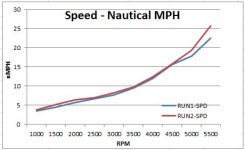Below are the fuel consumption curves for my last C Dory 25, with a 150 HP Honda, fuel injected. The course was run both ways in a 5 mile stretch of smooth water, with a little current.


As you can see the lower planing speeds, and transition from displacement to planing speed gave the worse fuel consumption figures. At the higher and good planing speeds the mileage smoothed out a just a little under 3mpg. As a boat transitions from displacement speed, and climbs over its bow wave, the fuel consumption is the poorest--yet many motor boat owners run their craft with "Maximum wake" speed--in the 10 to 14 knot range. They are getting the poorest fuel milage.
At the slowest speeds the fuel flow meters are not accurate and often one is getting better than what is registered on the fuel meter.
Tom Cat 255 with two Suzuki 150's I did a run of 200 miles on flat water, minimal current or breeze. The Speed was at 30 knots, except about 4 miles total of "no Wake Zone"--where my speed was 5 knots. Fuel usage was calculated by fill up to fill up and Lowrance fuel flow meters, which I had calibrated. The average for the trip was slightly over 2 miles per gallon. Overall during my ownership and several thousand miles of travel, I figured 1.8 miles per gallon to be on the "safe side".
As I have brought out before that slow speeds use very little HP--and that was illustrated by a 4.5 HP dinghy outboard got my 65,000, LWL 53' LOA 62' Ketch moving at about 2.5 miles per hour--and steerage way, when I lost the transmission on the 90 hp diesel engine. This gave me time to get the 13' inflatable boat with a 25 hp outboard engine pumped up and hoisted onto the water. The 25 hp (not ideal prop size of about 15", vs the diesel prop of 26".) gave us a speed of a little over 5 mph and control to dock the boat a few miles up the harbor. The Max speed was 9 knots and the 90 HP diesel engine running at WOT RPM of 2000. We normally cruised at 6 knots and about a gallon an hour--or 6 N. miles per gallon. The boat had a theoretical Hull speed of 9.8 knots and some were fitted with 120 hp engines, instead of the 90 hp. The larger engine boats would almost reach 10 ,knots. But they were digging a huge hole in the water. The boats full displacement lines, long deep keel, and doubled ended (at the water line) lines meant there was just no lift. On the other hand, I was watch captain on one of my friend's racing 55' Ultralight displacement sloop of only 20,000 lbs Boat, with a daggerboard, and mizzen board, working down wind sail area of about the same as my ketch--close to 3000 sq feet, including spinnaker and main. That boat would plane up to 22 knots in good downwind conditions. On a beam reach speeds over 12 knots were not uncommon with the right sea and wind state--again well beyond the "theoretical hull speed".a


